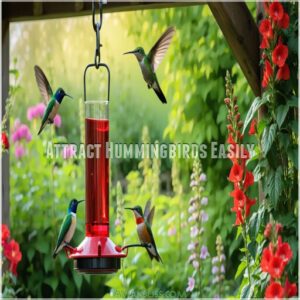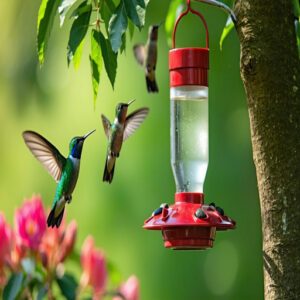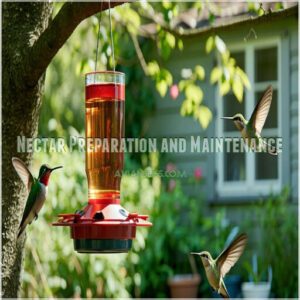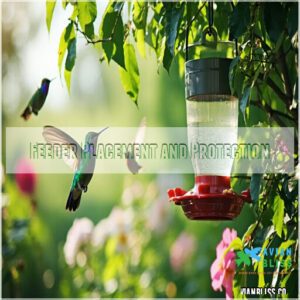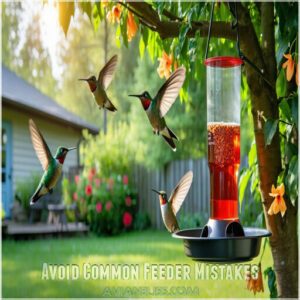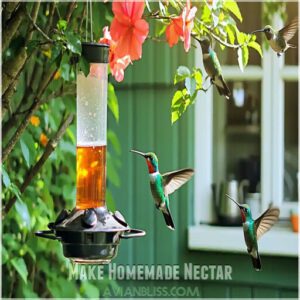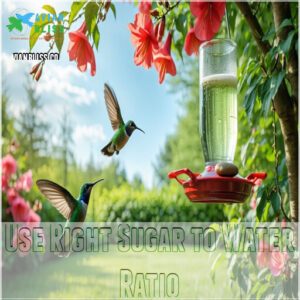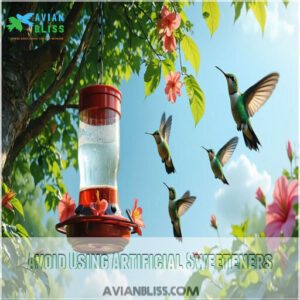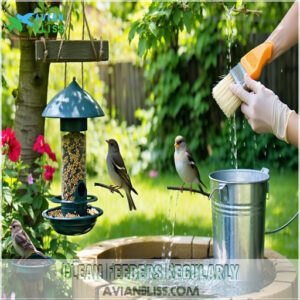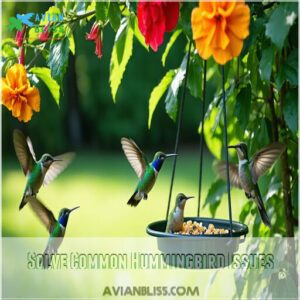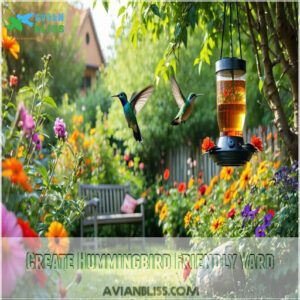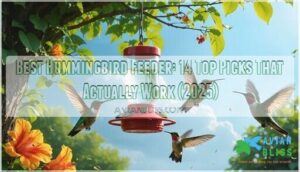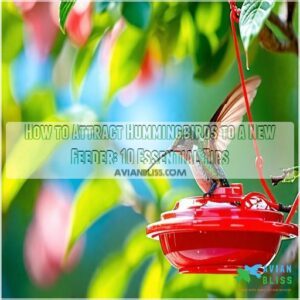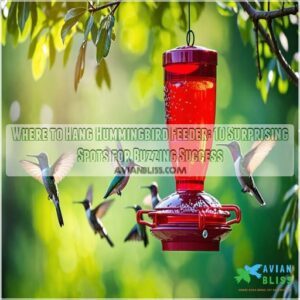This site is supported by our readers. We may earn a commission, at no cost to you, if you purchase through links.
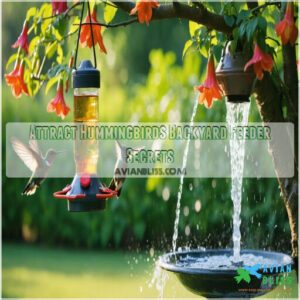
Place your feeder in a shaded spot, about 5-6 feet high, where these tiny acrobats can safely feed. Surround it with trumpet-shaped, nectar-rich flowers in bright colors – these natural fuel stations complement your feeder perfectly.
Keep the nectar fresh and clean, using a 4:1 water-to-sugar ratio without artificial dyes. Add a gentle water feature nearby; these aerial dancers love to zip through fine mist on hot days.
Just like setting up a cozy café, creating the perfect hummingbird spot is all about location and ambiance.
Table Of Contents
- Key Takeaways
- Attract Hummingbirds Easily
- Hummingbird Feeder Setup
- Hummingbird Nectar and Feeders
- Solve Common Hummingbird Issues
- Create Hummingbird Friendly Yard
- Frequently Asked Questions (FAQs)
- How do I get hummingbirds to come to my feeder?
- How long does it take hummingbirds to find a new feeder?
- Why are the hummingbirds not coming to my feeder?
- Should a hummingbird feeder be in the sun or shade?
- How long does it take hummingbirds to find feeders?
- Do hummingbirds remember and return to same feeders?
- What time of day are hummingbirds most active?
- Can multiple hummingbird species share the same feeder?
- Should feeders be taken down during rainy weather?
- Conclusion
Key Takeaways
- You’ll attract more hummingbirds by placing feeders in partial shade, 5-6 feet high, and surrounding them with trumpet-shaped flowers in bright colors that serve as natural nectar stations.
- You’ll need to maintain a clean feeder environment by replacing nectar every 2-3 days in hot weather, using a 4:1 water-to-sugar ratio without artificial dyes, and cleaning feeders thoroughly with hot water every 4-5 days.
- You’ll create a more inviting habitat by adding shallow water features, installing perches 10-15 feet from dense foliage, and using red decorations like ribbons and garden stakes to catch hummingbirds’ attention.
- You’ll keep pests away by installing ant moats, using feeder guards against bees, and checking regularly for leaks by inspecting seals and connections on your feeders.
Attract Hummingbirds Easily
You can attract hummingbirds easily by choosing the right feeder location and selecting nectar-rich flowers.
By following these simple steps, you’ll be able to create a hummingbird-friendly landscape that will make these beautiful birds feel right at home in your backyard.
Choose Right Feeder Location
To attract hummingbirds, choose a feeder location with shade selection in mind, considering yard layout and feeder height for sun protection, ensuring ideal hummingbird feeder placement in your backyard bird feeders, like a hummingbird feeder, for a pleasant experience.
Planting native flowers for hummingbirds provides a natural food source and supports the creation of a hummingbird-friendly yard.
Select Nectar Rich Flowers
You can create a hummingbird haven by selecting nectar rich flowers, like trumpet shaped ones, with varied bloom times.
Incorporating native species and colorful schemes to attract hummingbirds naturally with hummingbird friendly plants and hummingbird garden ideas.
Provide Shallow Water Sources
You’re setting up a hummingbird haven.
Consider water features like shallow ponds or birdbaths.
- Fountain tips
- Misting systems
- Drippers for a soothing atmosphere, making your yard a hummingbird oasis with shallow water sources and fountains.
Create Hummingbird Friendly Landscape
You’re making progress with shallow water sources.
Now, design a hummingbird friendly landscape with native plant selection and nectar rich flowers.
| Garden Layout | Soil Quality |
|---|---|
| Water Features | Landscape Design |
| hummingbird friendly | backyard wildlife |
The key elements to focus on include complete concepts such as water features and landscape design to create a cohesive backyard wildlife habitat.
Hummingbird Feeder Setup
You’re setting up your hummingbird feeder, and it’s imperative to get it right to attract these beautiful birds to your backyard.
By choosing the right feeder design and size, preparing the perfect nectar, and placing it in a strategic location, you’ll be well on your way to creating a hummingbird-friendly oasis.
Feeder Design and Size
When selecting a hummingbird feeder, consider feeder design and size.
Tube feeders with adequate nectar capacity and proper port size are ideal.
Durable feeder materials guarantee longevity.
Choose a feeder that suits your backyard feeders’ needs, considering feeder shapes and sizes to attract hummingbirds to your feeder.
Proper hummingbird feeder maintenance involves understanding hummingbird feeders to maintain the health and safety of the birds, which is a key aspect of using a hummingbird feeder.
Nectar Preparation and Maintenance
To prepare nectar, mix one part sugar with four parts water, boiling the mixture to prevent spoilage.
Store excess homemade nectar in the fridge for up to a week, cleaning feeders regularly to maintain a healthy sugar water ratio and maintain proper feeder maintenance.
Regular feeder cleaning is important for preventing hummingbird health issues, which is crucial for hummingbird care and requires proper maintenance.
Feeder Placement and Protection
To protect your feeder, hang it high for pest control, ideally in shade placement, and consider ant moats for feeder security.
Ensuring proper hummingbird feeder placement and maintenance for a safe haven, free from pests, with feeder height being a key factor in feeder protection and overall feeder maintenance, including the use of ant moats.
Avoid Common Feeder Mistakes
You’ll want to avoid common mistakes like poor feeder placement, nectar spoilage, and inadequate ant control.
Regular feeder cleaning and maintenance are key to preventing these issues and attracting hummingbirds to your yard with well-placed feeders and fresh nectar.
Understanding the importance of proper hummingbird feeder selection is paramount for creating an inviting environment with well-placed feeders.
Hummingbird Nectar and Feeders
You’ll want to create a nectar that’s appealing to hummingbirds, and that starts with using the right sugar-to-water ratio.
By making your own homemade nectar and using the right feeders, you can attract these beautiful birds to your backyard and keep them coming back for more.
Make Homemade Nectar
To make homemade nectar,
- Mix sugar and water
- Boil water to prevent fermentation
A proper sugar water ratio is essential for hummingbird health.
- Store nectar properly, creating a simple hummingbird food recipe with the right sugar ratio for your homemade nectar, a perfect sugar water mix for hummingbird nectar feeders, using the proper sugar water ratio.
Use Right Sugar to Water Ratio
When mixing sugar and water for your hummingbird feeder, use a 1:4 Nectar Ratio, combining one part sugar with four parts water.
This mixture ensures good Water Quality for a healthy Sugar Mix to prevent Nectar Spoilage and maintain Feeder Hygiene in your homemade nectar recipe for nectar feeders.
Avoid Using Artificial Sweeteners
Avoid artificial sweeteners in your hummingbird feeder. They can harm hummingbird health.
- Refine sugar
- Brown sugar
- Honey are bad alternatives.
Use natural nectar with the right sugar ratio for feeder safety and hummingbird attractants.
Clean Feeders Regularly
Clean your feeders regularly to prevent bacteria growth.
| Feeder Sanitation | Nectar Refresh | Cleaner Tools |
|---|---|---|
| Daily | Weekly | Brush |
| Weekly | Bi-Weekly | Vinegar |
| Bi-Weekly | Monthly | Soap |
| Monthly | Seasonal | Replacement |
| Seasonal | Yearly | Maintenance |
Solve Common Hummingbird Issues
You’ll encounter common issues when attracting hummingbirds to your backyard feeder, such as ants and bees taking over.
By addressing these problems, you can create a welcoming environment that encourages hummingbirds to visit and stay, which is the key to making your backyard a haven for these beautiful birds, with hummingbirds being the main focus.
Keep Ants Away From Feeders
Several strategies exist to keep ants from your hummingbird feeders.
Outsmart those tiny sugar bandits with these methods:
- Ant moats create a watery barrier.
- Feeder guards block access.
- Ant traps lure and capture.
- Sugar shields prevent spills.
- Ant repellents discourage approach.
Consider an effective ant moat system to deter these persistent pests.
Regular feeder maintenance, including feeder cleaning and spoilage prevention, also deters ants, and is an important part of an overall strategy to outsmart those tiny sugar bandits.
Deter Bees From Feeders
You can deter bees from feeders using Bee Repellent or Feeder Guards.
Consider Ant Moats for pest control, helping prevent spoilage and maintaining feeder maintenance tips for a safe nectar feeder experience.
Fix Leaking Feeders
Discovering a leaky hummingbird feeder can drain both your nectar and patience. Check the feeder’s seals and connections – they’re often the culprits behind those sticky drips.
You’ll want to tighten port connections, replace worn gaskets, and apply food-grade sealant to troublesome spots. Regular tube cleaning prevents buildup that causes leaks.
If the leak persists, it’s time for a new, reliable feeder. To prevent mold and bacteria growth, maintaining a feeder with proper cleaning techniques is essential for the health of the hummingbirds.
Address Nectar Spoilage
Spoiled nectar can drive hummingbirds away from your feeders faster than you can say "sugar water."
Keep these essential nectar feeder tips in mind:
- Replace nectar every 2-3 days during hot weather
- Watch for cloudiness, bubbles, or floating particles
- Position feeders in afternoon shade to prevent fermentation
- Clean thoroughly with hot water every 4-5 days to maintain freshness
Stick to these guidelines, and you’ll keep your tiny visitors buzzing back for more.
Create Hummingbird Friendly Yard
You’ll transform your backyard into a hummingbird paradise by combining native flowers, bright decorations, and strategic resting spots.
Your yard’s design will work with local migration patterns to attract these fascinating aerial acrobats throughout their active season.
Plant Native Flowers
Your garden’s native plants are like a natural buffet for hummingbirds.
Plant tubular or funnel-shaped blossoms in red, orange, blue, and purple to create an irresistible feast. Honeysuckle, trumpet creeper, and salvia are perfect choices.
For a steady stream of visitors, mix perennials and blooming shrubs that flower throughout summer. Remember to check your site’s light and moisture needs when planning your hummingbird-friendly oasis to ensure a steady stream of visitors.
Provide Resting Places
Tired hummingbirds need spots to rest their wings between feeding sessions.
Install perches and hummingbird swings near your feeders, placing them 10-15 feet from dense foliage.
Natural branch placement works well – try mounting small twigs or dowels horizontally.
You’ll also want to add roosting sites like nesting boxes in sheltered areas.
Don’t forget to include misters nearby – they’ll appreciate the cooling spray.
Use Bright Colors and Decor
While your hummingbird rest spots are set, let’s make them pop with color! Bright decor and red accents catch these tiny flyers’ attention from high above.
You’ll love watching them zoom toward your colorful garden display. Here’s what works best:
- Hang red ribbons near feeders to catch the sunlight
- Place shiny garden globes among vibrant flowers
- Scatter trumpet vines with their tubular flowers
- Add metallic windchimes that sparkle
- Paint garden stakes or trellises in bold reds and oranges
Creating a bird friendly environment with proper water and hydration methods can also attract more hummingbirds to your yard, making it a hummingbird haven with the right garden display.
Research Local Hummingbird Migration Patterns
Beyond the bright garden decor, understanding migration timing helps you welcome these tiny travelers.
You’ll maximize visits by knowing when hummingbirds pass through your region. Check out these typical patterns:
| Region | Spring Arrival | Fall Departure |
|---|---|---|
| Southern | February-March | October-November |
| Central | March-April | September-October |
| Northern | April-May | August-September |
Different species follow unique migration routes based on geographic variations and climate factors, so research your local patterns for the best results, considering the importance of local patterns and geographic variations.
Frequently Asked Questions (FAQs)
How do I get hummingbirds to come to my feeder?
Place red feeders in shaded spots near nectar-rich flowers, away from other bird feeders. Keep nectar fresh, clean feeders weekly, and add native plants to create an irresistible hummingbird haven.
How long does it take hummingbirds to find a new feeder?
While you’re hopefully watching that empty feeder, remember patience is key.
It typically takes 2-4 weeks for hummingbirds to discover your new setup, but they’ll spread the word once they do.
Why are the hummingbirds not coming to my feeder?
Your feeder might need fresh nectar, better placement, or cleaning.
Check if it’s in a shady spot, away from predators.
Consider adding native flowers nearby and ensuring you’re using the right sugar ratio.
Should a hummingbird feeder be in the sun or shade?
You’ll want to hang your feeder in partial shade to keep nectar fresh longer and prevent spoilage.
While morning sun is okay, afternoon shade protects the sweet liquid from fermenting too quickly, which is a complete concept to consider for the feeder’s placement.
How long does it take hummingbirds to find feeders?
Like tiny explorers on a mission, hummingbirds can discover your feeders within hours or up to a week.
You’ll have better luck during migration seasons when they’re actively searching for food sources.
Do hummingbirds remember and return to same feeders?
Hummingbirds possess remarkable spatial memory and will return to reliable food sources year after year.
You’ll often spot these tiny travelers visiting the same spots where they’ve previously found tasty treats.
What time of day are hummingbirds most active?
You’d think these tiny dynamos rest at noon, but they’re actually busiest at dawn and dusk.
You’ll catch them darting between flowers and feeders from sunrise until about 9 AM and again before sunset.
Can multiple hummingbird species share the same feeder?
You’ll often see different species sharing feeders, though territorial males may try to claim them.
Don’t worry – placing multiple feeders in your space helps reduce competition and guarantees everyone gets their fill.
Should feeders be taken down during rainy weather?
You don’t need to remove feeders during rain since these hardy birds will still feed.
Just make sure your feeder has good drainage and coverage to prevent water from diluting the nectar.
Conclusion
Picturesque patterns of darting hummingbirds will fill your yard when you follow these proven tips to attract hummingbirds with backyard feeders.
You’ll create an inviting oasis by combining strategic feeder placement, native nectar-rich flowers, and proper maintenance.
Remember, success comes from consistency – keep feeders clean, nectar fresh, and your garden welcoming.
Soon you’ll enjoy these fascinating aerial acrobats as they make your backyard their favorite pit stop on their daily nectar-gathering adventures, and experience the thrill of watching hummingbirds up close.
- https://lurveys.com/the-top-3-tips-to-attract-more-hummingbirds/
- https://www.natureswaybirds.com/blogs/news/how-to-attract-hummingbirds
- https://www.birdsandblooms.com/birding/attracting-hummingbirds/tips-attracting-hummingbirds/
- https://www.grangecoop.com/grangeknows/how-to-attract-hummingbirds-to-your-backyard/
- https://wildbirdhabitatstore.com/attracting-hummingbirds/

